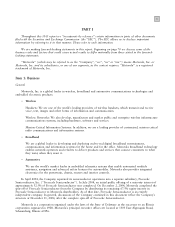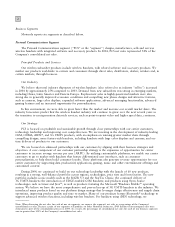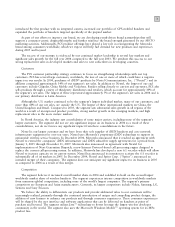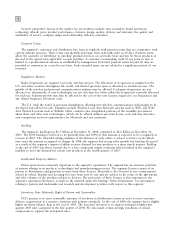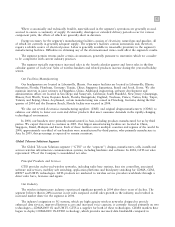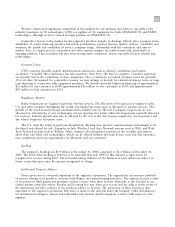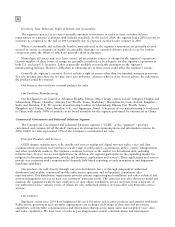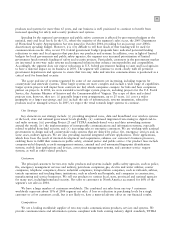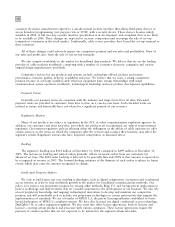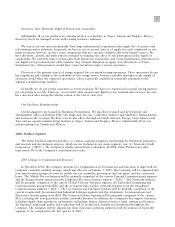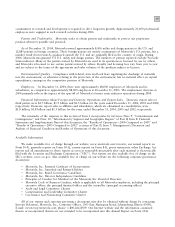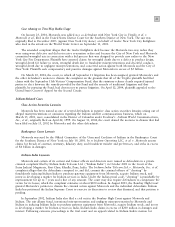Motorola 2004 Annual Report Download - page 19
Download and view the complete annual report
Please find page 19 of the 2004 Motorola annual report below. You can navigate through the pages in the report by either clicking on the pages listed below, or by using the keyword search tool below to find specific information within the annual report.
11
Intellectual Property Matters
Patent protection is very important to the segment's business. We actively participate in the development of
open standards for interoperable, mission critical digital two-way radio systems. We have published our technology
and licensed patents to signatories of the industry's two primary memorandums of understanding deÑned by the
Telecommunications Industry Association (TIA) Project 25 and European Telecommunications Standards Institute
(ETSI) Terrestrial Trunked Radio (TETRA). Royalties associated with these licenses are not expected to be
material to the segment's Ñnancial results. Reference is made to the material under the heading ""Other
Information'' for information relating to patents and trademarks, and research and development activities with
respect to this segment.
Inventory, Raw Materials, Right of Return and Seasonality
The segment provides custom products based on assembling basic units into a large variety of models or
combinations. This requires the stocking of inventories and large varieties of piece parts and replacement parts, as
well as a variety of basic level assemblies in order to meet delivery requirements. Relatively short delivery
requirements and historical trends determine the amounts of inventory to be stocked. To the extent suppliers'
product life cycles are shorter than the segment's, stocking of lifetime buy inventories is required. In addition,
replacement parts are stocked for delivery on customer demand within a short delivery cycle, including radios that
have been canceled within the last 10 years.
Availability of the materials and components required by the segment is relatively dependable, but normal
Öuctuations in market demand and supply could cause temporary, selective shortages and aÅect results. Direct
sourcing of materials and components from foreign suppliers is becoming more extensive. We operate certain
oÅshore manufacturing plants, the loss of one or more of which could constrain our production capabilities and
aÅect the segment's Ñnancial results. We currently source certain raw materials from single vendors. Any material
disruption from a single-source vendor may have a material adverse impact on our operations.
Natural gas, electricity and, to a lesser extent, oil are the primary sources of energy for the segment's
operations. Current supplies of these forms of energy are generally considered to be adequate for this segment's
operations. Labor is generally available in reasonable proximity to the segment's manufacturing facilities. However,
diÇculties in obtaining any of these items could aÅect the segment's results.
Generally, we do not permit customers to return products. We typically have stronger sales in the fourth
quarter of the year because of government and commercial spending patterns, as well as the timing of new product
releases.
Our Facilities/Manufacturing
Our headquarters are located in Schaumburg, Illinois, and our major manufacturing and distribution facilities
are located in Elgin and Schaumburg, Illinois; Tianjin, China; Penang, Malaysia; Berlin and Taunusstein, Germany;
and Arad, Israel. The majority of our products are integrated/manufactured in Schaumburg, Illinois; Berlin,
Germany; and Penang, Malaysia.
Integrated Electronic Systems Segment
The Integrated Electronic Systems segment (""IESS'' or the ""segment'') designs, manufactures and sells:
(i) automotive and industrial electronics systems, (ii) telematics systems that enable automated roadside assistance,
navigation and advanced safety features for automobiles, (iii) portable energy storage products and systems, and
(iv) embedded computing systems. In 2004, IESS net sales represented 9% of the Company's consolidated net sales.
Principal Products and Services
The Automotive Communications and Electronic Systems Group (""ACES'') consists of three businesses: the
Powertrain Chassis and Systems Group (""PCSG''), the Interior Electronics Division (""IED''), and the Telematics
Communications Group (""TCG''). PCSG and IED use application and engineering expertise to design and sell
custom electronic systems for original equipment manufacturers (""OEMs''), which may include foreign and
domestic automobile manufacturers, heavy vehicle manufacturers, farm equipment manufacturers and industrial
customers, as well as Ñrst-tier suppliers to such manufacturers. TCG provides automotive customers with embedded


